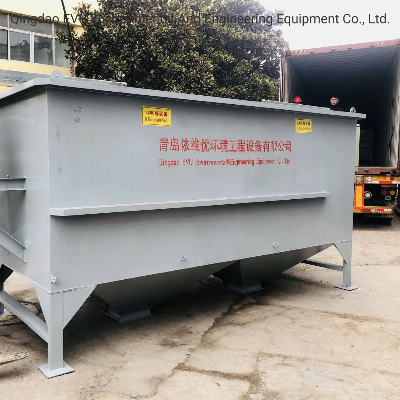Electrical Coagulation Machine Electrocoagulation Ec Equipment with
Ec Technology Product DescriptionELECTROCOAGULATION SYSTEM
INTRODUCTIONElectrocoagulation (EC), is a technique used
for wastewater treatment, wash water treatment,
industrial processed water, and medical treatment.
Electrocoagulation has become a rapidly growing area of wastewater
treatment due to its ability to remove contaminants that are
generally more difficult to remove by filtration or chemical
treatment systems, such as emulsified oil, total
petroleum hydrocarbons, refractory organics, suspended solids,
and heavy metals. There are many brands of electrocoagulation
devices available and they can range in complexity from a simple
anode and cathode to much more complex devices with control over
electrode potentials, passivation, anode consumption, cell REDOX
potentials as well as the introduction of ultrasonic sound,
ultraviolet light and a range of gases and reactants to achieve
so-called Advanced Oxidation Processes
for refractory or recalcitrant organic
substances.Detailed PhotosProduct ParametersELECTROCOAGULATION
SYSTEM WORKING PRICINPLEElectrochemical reaction:
Fe→Fe2++2eAnodizing reaction: 2OH-→2[O]+2e→02+2e, The nascent
oxygen [O] has the same strong oxidation function as UV, H2O2 and
O3.Cathode reduction: 2H++2e→2[H]→H2, nascent hydrogen can break
bonds, COD, chromophore functional groups and multi-chain
health.The above oxidation and reduction functions occur
continuously on the plates.ADVANTAGESEC requires simple equipment
and is easy to operate with sufficient operational latitude to
handle most problems encountered on running.Wastewater treated by
EC gives palatable, clear, colorless and odorless water.Sludge
formed by EC tends to be readily settable and easy to de-water,
compared to conventional alum or ferric hydroxide sludges, because
the mainly metallic oxides/hydroxides have no residual charge.Flocs
formed by EC are similar to chemical floc, except that EC floc
tends to be much larger, contains less bound water, is
acid-resistant and more stable, and therefore, can be separated
faster by filtration.EC can produce effluent with less TDS content
as compared with chemical treatments, particularly if the metal
ions can be precipitated as either hydroxides or carbonates (such
as magnesium and calcium. EC generally has little if any impact on
sodium and potassium ions in solution.The EC process has the
advantage of removing the smallest colloidal particles, because the
applied electric field neutralises any residual charge, thereby
facilitating the coagulation.The EC process generally avoids
excessive use of chemicals and so there is reduced requirement to
neutralize excess chemicals and less possibility of secondary
pollution caused by chemical substances added at high concentration
as when chemical coagulation of wastewater is used.The gas bubbles
produced during electrolysis can conveniently carry the pollutant
components to the top of the solution where it can be more easily
concentrated, collected and removed by a motorised skimmer.The
electrolytic processes in the EC cell are controlled electrically
and with no moving parts, thus requiring less maintenance.Dosing
incoming waste water with sodium hypochlorite assists
reduction of biochemical oxygen demand (BOD) and
consequent chemical oxygen demand (COD) although this
should be avoided for wastewater containing high levels of organic
compounds or dissolved ammonia (NH4+) due to formation
of trihalogenated methanes (THMs) or
other chlorinated organics. Sodium hypochlorite can be
generated electrolytically in an E cell using platinum and similar
inert electrodes or by using external electrochlorinators.Due to
the excellent EC removal of suspended solids and the simplicity of
the EC operation, tests conducted for the U.S. Office of Naval
Research concluded that the most promising application of EC
in a membrane system was found to be as pretreatment to a
multi-membrane system of UF/RO or microfiltration/reverse
osmosis (MF/RO). In this function the EC provides protection of the
low-pressure membrane that is more general than that provided by
chemical coagulation and more effective. EC is very effective at
removing a number of membrane fouling species (such as silica,
alkaline earth metal hydroxides and transition group metals) as
well as removing many species that chemical coagulation alone
cannot remove. CertificationsPackaging & ShippingCompany
ProfileWe're All About The Process - Since 1999.For over 30 years,
QDEVU Process Equipment has been committed to producing the
most efficient and reliable technology for tailings dewatering,
liquid solid separation, fine particle wet classification and
separation, slurry and sludge thickening, effluent water treatment,
and water purification and water recycling. Years of designing and
fabricating, while refining and improving our techniques ensures we
understand your process. We have always placed process
engineering at the absol
Related products about High-Quality Ec Electrocoagulation Electrolysis Water Treatment Equipment Industrial Machinery
-
 Waste Tyre Plastic Recycling Machinery Machine Tire Crusher Production Line Rubber Crumb Grinding Machine Equipment Tire Shredder
Waste Tyre Plastic Recycling Machinery Machine Tire Crusher Production Line Rubber Crumb Grinding Machine Equipment Tire Shredder
-
 Stretch Plastic Blowing Pet Bottle Making Blow Molding Machine Bottles Stretch Automatic Pet Bottle Blowing Machine
Stretch Plastic Blowing Pet Bottle Making Blow Molding Machine Bottles Stretch Automatic Pet Bottle Blowing Machine
-
 Waste Plastic Pet Bottle, Water Bottle Flake, PP/HDPE/LDPE PE Film Jumbo Woven Bags Plastic Crusher Machine, Plastic Crushing Washing Recycling Machine
Waste Plastic Pet Bottle, Water Bottle Flake, PP/HDPE/LDPE PE Film Jumbo Woven Bags Plastic Crusher Machine, Plastic Crushing Washing Recycling Machine
-
 Type 2 Wall-Mounted Electric Car Charging Station 7kw /11 Kwelectric Vehicle Charging Station Home Wallbox AC EV Charger Single Phase or 3three Phase
Type 2 Wall-Mounted Electric Car Charging Station 7kw /11 Kwelectric Vehicle Charging Station Home Wallbox AC EV Charger Single Phase or 3three Phase
-
 G-View G12W Wholesale Auto Car LED Headlight Bulb High Power H13 H11 9005 H7 H4 Car LED Headlights LED Car Lights
G-View G12W Wholesale Auto Car LED Headlight Bulb High Power H13 H11 9005 H7 H4 Car LED Headlights LED Car Lights
-
 New Design Porcelain Round Plates Dinner Set for Wedding and Banquet
New Design Porcelain Round Plates Dinner Set for Wedding and Banquet
-
 China 2023 New Design Super Soft 100% Polyester Microfiber Knitted Oversized Decoration Hoodie Blanket
China 2023 New Design Super Soft 100% Polyester Microfiber Knitted Oversized Decoration Hoodie Blanket
-
 Handmade Art Creative Materials Thickened White Paper Cup DIY Disposable Handmade Colored Paper Cup
Handmade Art Creative Materials Thickened White Paper Cup DIY Disposable Handmade Colored Paper Cup



